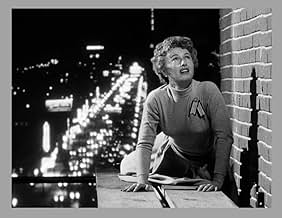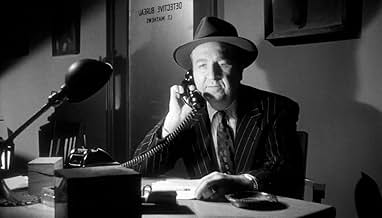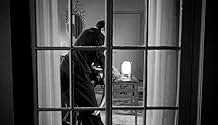VALUTAZIONE IMDb
6,6/10
3680
LA TUA VALUTAZIONE
Aggiungi una trama nella tua linguaA woman's sanity comes into question, after she claims to have witnessed a murder from her apartment window.A woman's sanity comes into question, after she claims to have witnessed a murder from her apartment window.A woman's sanity comes into question, after she claims to have witnessed a murder from her apartment window.
- Regia
- Sceneggiatura
- Star
Adeline De Walt Reynolds
- The Old Lady
- (as Adeline de Walt Reynolds)
Claude Akins
- Police Officer
- (non citato nei titoli originali)
Ralph Brooks
- Man at Lunch Counter
- (non citato nei titoli originali)
Russell Custer
- Police Officer
- (non citato nei titoli originali)
Sam Edwards
- Tommy
- (non citato nei titoli originali)
Jean Fenwick
- Nurse
- (non citato nei titoli originali)
Fred Graham
- Plainclothes Man
- (non citato nei titoli originali)
Recensioni in evidenza
"Witness to Murder" is a small but interesting film starring Barbara Stanwyck, George Sanders, and Gary Merrill. By 1954, Stanwyck was 47 and no longer considered leading lady material. However, because she was such a great star and actress, she could still get good roles in big films, "Titanic" and "Executive Suite" being two that leap to mind. She could also, like Loretta Young, get stuck in B movies like this one and "Jeopardy." "Witness to Murder" isn't so much a B movie as it is closer to what one was seeing on television by 1954. And it's not a B cast.
Stanwyck plays a career woman, Cheryl, of a certain age who sees a woman murdered in the apartment across from hers. The apartment belongs to an author, Albert Richter, who emigrated to America after the war. Cheryl reports the murder but no one believes her. Richter is too smooth and always one step ahead of her with the police. Cheryl is considered an hysterical single woman who has delusions because she isn't married and probably going through menopause, though this isn't out and out stated. Completely outrageous and no doubt what actually went on at the time. These assumptions were just taken for granted in the '50s. There was something really wrong with a woman who never married. Read LOSER. A woman's goal in life was marriage; the career was just a stopgap until the ring was on the finger. What must it have been like for an intelligent woman to have that mantle put on her. In this film, the police detective (Gary Merrill) is interested enough in her to at least follow the case.
All of the acting is very good, with Stanwyck really shining as someone determined to get the truth out, even if she has to do a little detective work herself. Sanders is very effective as the villainous Richter, and he's pretty scary at the end of the film. The last 15 minutes or so are exciting and will have you on the edge of your seat.
This is actually a fairly derivative film bolstered by its stars. And you can't beat the opportunity to see the attitudes toward women played out in a realistic manner. Alas, there are still touches of it today.
Stanwyck plays a career woman, Cheryl, of a certain age who sees a woman murdered in the apartment across from hers. The apartment belongs to an author, Albert Richter, who emigrated to America after the war. Cheryl reports the murder but no one believes her. Richter is too smooth and always one step ahead of her with the police. Cheryl is considered an hysterical single woman who has delusions because she isn't married and probably going through menopause, though this isn't out and out stated. Completely outrageous and no doubt what actually went on at the time. These assumptions were just taken for granted in the '50s. There was something really wrong with a woman who never married. Read LOSER. A woman's goal in life was marriage; the career was just a stopgap until the ring was on the finger. What must it have been like for an intelligent woman to have that mantle put on her. In this film, the police detective (Gary Merrill) is interested enough in her to at least follow the case.
All of the acting is very good, with Stanwyck really shining as someone determined to get the truth out, even if she has to do a little detective work herself. Sanders is very effective as the villainous Richter, and he's pretty scary at the end of the film. The last 15 minutes or so are exciting and will have you on the edge of your seat.
This is actually a fairly derivative film bolstered by its stars. And you can't beat the opportunity to see the attitudes toward women played out in a realistic manner. Alas, there are still touches of it today.
This is a great example of "film noir," as every scene has some sort of shadow pattern on the wall, the floor, the faces. All shots are done with key light on the faces. The patterns suggest "jail," "locked up," "flight" (as in a train track), "trapped," (as in a cobweb), and others. There isn't one scene that doesn't have a shadow in it! Even the day time sequences. And the actors that had great careers: Stanwyck, Gary Merrill, Claude Akins, even Jesse (the original maytag repairman) White, and, of course, George Sanders, who plays a "deNazified" ex-Nazi. Whew! Great stuff.
Perhaps Barbara Stanwyck was looking to score another Oscar with Witness To
Murder. Her fourth and final nomination was with Sorry Wrong Number. In
that film she overhears a murder plot.
In this one she sees neighbor George Sanders commit a strangulation on some woman. But the police show up and no body and no signs of struggle. Still Stanwyck persists and detectives Gary Merrill and Jesse White do their best..
We learn too early that Sanders did the deed which robs us of suspense. Still Sanders is at his caddiest and that's always a treat.
The best scenes are Stanwyck in a mental ward and she's in with a lot of those you would have seen in the Snake Pit. Wonderful scene allowing all the players including Stanwyck to overact and stay in character.
Timing is everything and Witness To Murder was released first so it was no copycat. But Alfred Hitchcock's Rear Window with the same premise and all those Hitch touches came out far superior and this film was forgotten.
Stanwyck and the cast do a good job though and Witness To Murder should not be forgotten.
In this one she sees neighbor George Sanders commit a strangulation on some woman. But the police show up and no body and no signs of struggle. Still Stanwyck persists and detectives Gary Merrill and Jesse White do their best..
We learn too early that Sanders did the deed which robs us of suspense. Still Sanders is at his caddiest and that's always a treat.
The best scenes are Stanwyck in a mental ward and she's in with a lot of those you would have seen in the Snake Pit. Wonderful scene allowing all the players including Stanwyck to overact and stay in character.
Timing is everything and Witness To Murder was released first so it was no copycat. But Alfred Hitchcock's Rear Window with the same premise and all those Hitch touches came out far superior and this film was forgotten.
Stanwyck and the cast do a good job though and Witness To Murder should not be forgotten.
In addition to its solid performances, tight storytelling and John Alton's superior cinematography, what makes "Witness to Murder" particularly powerful today is the movie's pre-feminist view of its leading character's dilemma. "But I saw the murder, I SAW the murder," the Stanwyck character insists. Yet no one believes her because 1) she's a woman; 2) she's unmarried; 3) she's menopausal. Nobody even blinks an eye when she's dumped in a mental hospital, which gets viewers really riled because they share her point of view. The audience sees the murder along with Stanwyck and can feel her humiliation, anger and frustration. That's why the movie works.
Witness to Murder (1954)
** 1/2 (out of 4)
Great performances are somewhat wasted in this thriller that simply has way too many logical problems to really work. Cheryl (Barbara Stanwyck) wakes up one night and looks across the street to an open window where she sees a man (George Sanders) kill a woman. Cheryl goes to the police but they don't believe her and after a while they start to think she's the one that is crazy. She strikes up a relationship with the lead detective (Gary Merrill) but the only person who knows she's telling the truth is the killer himself. WITNESS TO MURDER features three great performances from the leads but sadly there are just way too many logic issues that keep this from being a complete winner. As many other reviewers have pointed out, there were times where I wanted to jump through the screen and just smack the detective and those helping on this case. It doesn't help that right from the start no one is taking the woman serious because if anyone had done the smallest amount of work then there were all sorts of signs that she was telling the truth. Another big problem is that the Sanders character can pretty much do whatever he wants, no matter how silly it is, and the police will never question it. After a while you pretty much just have to throw your hands in the air. Another major problem I had was with the music score, which was just constantly on and being way too dramatic for its own good. With that said, the three leads really make the film worth watching and especially Sanders who is terrific as the villain. He does a great job at playing this rather dark character and I loved the way the actor played it up to scare Stanwyck while playing it cool and collective whenever facing the police. Director Roy Rowland does a nice job with the ending, which contains some suspense but sadly the screenplay doesn't give him more to work with.
** 1/2 (out of 4)
Great performances are somewhat wasted in this thriller that simply has way too many logical problems to really work. Cheryl (Barbara Stanwyck) wakes up one night and looks across the street to an open window where she sees a man (George Sanders) kill a woman. Cheryl goes to the police but they don't believe her and after a while they start to think she's the one that is crazy. She strikes up a relationship with the lead detective (Gary Merrill) but the only person who knows she's telling the truth is the killer himself. WITNESS TO MURDER features three great performances from the leads but sadly there are just way too many logic issues that keep this from being a complete winner. As many other reviewers have pointed out, there were times where I wanted to jump through the screen and just smack the detective and those helping on this case. It doesn't help that right from the start no one is taking the woman serious because if anyone had done the smallest amount of work then there were all sorts of signs that she was telling the truth. Another big problem is that the Sanders character can pretty much do whatever he wants, no matter how silly it is, and the police will never question it. After a while you pretty much just have to throw your hands in the air. Another major problem I had was with the music score, which was just constantly on and being way too dramatic for its own good. With that said, the three leads really make the film worth watching and especially Sanders who is terrific as the villain. He does a great job at playing this rather dark character and I loved the way the actor played it up to scare Stanwyck while playing it cool and collective whenever facing the police. Director Roy Rowland does a nice job with the ending, which contains some suspense but sadly the screenplay doesn't give him more to work with.
Lo sapevi?
- QuizIn an unusual connection for the time (or possibly a product placement), the W&J Sloan Company in Beverly Hills - where Cheryl worked - was a real furniture and interior decorating firm founded in New York City in 1843. It went bankrupt in 1985. According to the end credits, the company supplied set decorations and furnishings for the film.
- BlooperThe story is taking place in Los Angeles, but the map on the wall in Larry's office is that of San Francisco.
- Citazioni
[repeated line]
The Old Lady - Mental Patient: Show Mr. Peabody into the library please.
- ConnessioniFeatured in Frances Farmer Presents: Witness to Murder (1959)
I più visti
Accedi per valutare e creare un elenco di titoli salvati per ottenere consigli personalizzati
Dettagli
- Data di uscita
- Paese di origine
- Lingue
- Celebre anche come
- Testigo del crimen
- Luoghi delle riprese
- Linda Vista Apartments, 939 S. Serrano Ave., Los Angeles, California, Stati Uniti(Cheryl Draper's apartment building)
- Azienda produttrice
- Vedi altri crediti dell’azienda su IMDbPro
- Tempo di esecuzione1 ora 23 minuti
- Colore
- Proporzioni
- 1.75 : 1
Contribuisci a questa pagina
Suggerisci una modifica o aggiungi i contenuti mancanti

Divario superiore
By what name was Ti ho visto uccidere (1954) officially released in India in English?
Rispondi
![Guarda Trailer [EN]](https://m.media-amazon.com/images/M/MV5BYjI4NDBiYmQtN2U0MS00MTdjLWI0YzEtODBkYjE0YjQ1MDc4XkEyXkFqcGdeQXRyYW5zY29kZS13b3JrZmxvdw@@._V1_QL75_UX500_CR0)
































